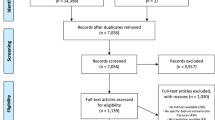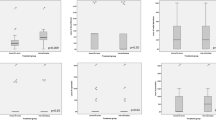Abstract
Purpose
There remains little consensus regarding the optimal management of distal radius fractures. Fixed angle volar devices have gained recent popularity, but have also been associated with soft tissue complications. Intramedullary (IM) devices offer fixed angle stabilisation with minimally invasive surgical technique and low, IM profile. No formal review of outcomes could be identified.
Methods
We conducted a systematic review of clinical studies regarding the use of fixed angle IM devices in acute extra-articular or simple intra-articular distal radius fractures. Preferred Reporting Items for Systematic Reviews (PRISMA) guidance was followed. Numerical data regarding functional scores, ranges of movement, radiological outcomes and complications were pooled to produce aggregate means and standard deviation.
Results
A total of 310 titles and abstracts were identified. Fourteen papers remained for analysis. Total patient number was 357, mean age 63.72 years and mean follow-up 12.77 months. Mean functional scores were all rated as ‘excellent’. Aggregate means: flexion 53.62°, extension 56.38°, pronation 69.10°, supination 70.29°, ulnar deviation 28.35°, radial deviation 18.12°, radial height 8.98 mm, radial inclination 16.51°, volar tilt 5.35°, ulnar variance 0.66 mm and grip strength 90.37 %. Overall complication rate was 19.6 %. Tendon rupture was unreported. Tendon irritation was 0.88 %. Radial nerve paraesthesia was 11.44 %.
Conclusions
Fixed angle IM devices facilitate excellent functional outcomes, with radiological and clinical parameters at least equivalent to volar plate devices. Low rates of tendon irritation and absence of tendon rupture are advantageous. Significant limitations include a lack of application for complex articular injuries and the propensity to cause a transient neuritis of the superficial branch of the radial nerve.


Similar content being viewed by others
References
Nellans KW, Kowalski E, Chung KC (2012) The epidemiology of distal radius fractures. Hand Clin 28:113–125
Larsen CF, Lauristen J (1993) Epidemiology of acute wrist trauma. Int J Epidemiol 22:911–916
Shauver MJ, Yin H, Banarjee M et al (2011) Current and future national costs to Medicare for the treatment of distal radius fracture in the elderly. J Hand Surg Am 36:1282–1287
Handoll H, Madhok R (2003) Surgical interventions for treating distal radial fractures in adults. Cochrane Database Syst Rev 3:CD003209
Ng CY, McQueen MM (2011) What are the radiological predictors of functional outcome following fractures of the distal radius? J Bone Joint Surg Br 93:145–150
McQueen M, Caspers J (1988) Colles fracture: does the anatomical result affect the final function? J Bone Joint Surg Br 70:649–651
Wilcke MK, Abbaszadegan H, Adolphson PY (2007) Patient-perceived outcomes after displaced distal radius fractures. A comparison between radiological parameters, objective physical variables, and the DASH score. J Hand Ther 20:290–298
Chung KC, Watt AJ, Kotsis SV et al (2006) Treatment of unstable distal radial fractures with the volar locking plate system. J Bone Joint Surg Am 88:2687–2694
Mellstrand-Nevaro C, Pettersson HJ, Tornqvist H, Ponzer S (2014) The operative treatment of fractures of the distal radius is increasing: results from a nationwide Swedish study. Bone Joint J 96-B:963–969
Bentohami A, de Burtlet K, de Korte N, van den Bekerom JC, Goslings JC, Schep NW (2014) Complications following volar locking plate fixation for distal radius fractures: a systematic review. J Hand Surg Eur Vol 39(7):745–754
Williksen JH, Frighagen F, Hellund JC, Kvernmo HD, Husby T (2013) Volar locking plates versus external fixation and adjuvant pin fixation in unstable distal radius fractures: a randomized, controlled study. J Hand Surg Am 38:1469–1476
Knight D, Hajducka C, Will E, McQueen M (2010) Locked volar plating for unstable distal radial fractures: clinical and radiological outcomes. Injury 41:184–189
Chen Y, Chau Y, Cheng C, Tsai M, Chen A (2012) Treatment of extra-articular distal radius fractures using an intramedullary nail. Formos J Musculoskelet Dis 3:116–120
Hozo SP, Djulbegovic B, Hozo I (2005) Estimating the mean and variance from the median, range, and the size of a sample. BMC Med Res Methodol 5:13
Dremstrup L, Skærbæk M, Olesen S, Høgh S, Hansen T (2013) Good radiological and functional results after intramedullary nailing of distal radius fractures. J Plast Surg Hand Surg 47:286–288
Geerts RW, Toonen HG, van Unen JM, van Vugt R, Werre AJ (2011) A new technique in the treatment of distal radius fractures: the Micronail®. Acta Orthop Traumatol Turc 45(2):85–93
Gradl G, Mielsch N, Wendt M, Falk S, Mittlmeirer T, Gierer P et al (2014) Intramedullary nail versus volar plate fixation of extra-articular distal radius fractures. Two year results of a prospective randomized trial. Injury 45(Suppl 1):S3–S8
Ilyas A, Thoder J (2008) Intramedullary fixation of displaced distal radius fractures: a preliminary report. J Hand Surg Am 33:1706–1715
Nishiwaki M, Tazaki K, Shimizu H, Ilyas A (2011) Prospective study of distal radius fractures treated with an intramedullary nail. J Bone Joint Surg Am 93:1436–1441
Rhee PC, Shin AY (2012) Minimally invasive flexible insertion and rigid intramedullary nail fixation for distal radius fractures. Tech Hand Up Extrem Surg 16:159–165
Safi A, Hart R, Těknědžjan B, Kozák T (2013) Treatment of extra-articular and simple articular distal radial fractures with intramedullary nail verus volar locking plate. J Hand Surg Eur Vol 38:774–779
Schønnemann JO, Hansen TB, Søballe K (2011) Randomised study of non-bridging external fixation compared with intramedullary fixation of unstable distal radial fractures. J Plast Surg Hand Surg 45:232–237
Tajima K, Koba T, Takao E (2012) A simple reduction technique in intramedullary nailing (MICRONAIL) of distal radius fracture - intrafocal elastic-spring pinning method. Hand Surg 17(2):279–285
Takada N, Otsuka T, Kondo A, Fukuta M, Suzuki H, Yamada K (2011) Minimally invasive osteosynthesis with an intramedullary nail for osteoporotic distal radius fractures. Eur J Orthop Surg Traumatol 21:503–509
Tan V, Bratchenko W, Nourbakhsh A, Capo J (2012) Comparative analysis of intramedullary nail fixation versus casting for treatment of distal radius fractures. J Hand Surg Am 37:460–468
van Vugt R, Geerts RW, Werre AJ (2010) Osteosynthesis of distal radius fractures with the Micronail®. Eur J Trauma Emerg Surg 36:471–476
Zehir S, Calbiyik M, Zehir R et al (2014) Intramedullary repair device against volar plating in the reconstruction of extra-articular and simple articular distal radius fractures; a randomized pilot study. Int Orthop 38:1655–1660
Amadio PC, Berquist TH, Smith DK, Ilstrup DM, Cooney WP, Linscheid RL (1989) Scaphoid malunion. J Hand Surg Am 14(4):679–687
Gartland J, Werley CW (1951) Evaluation of healed Colles’ fractures. J Bone Joint Surg Am 33-A(4):895–907
Mattyasovszky SG, Burkhart KJ, Ahlers C et al (2011) Isolated fractures of the greater tuberosity of the proximal humerus: a long-term retrospective study of 30 patients. Acta Orthop 82(6):714–720
Fernandez DL, Jupiter JB (1995) Fractures of the distal radius: a practical approach to management. Springer, New York, pp 54–65
Jenkins NH, Mintowt-Czyz WJ (1988) Mal-union and dysfunction in Colles’ fracture. J Hand Surg Br 13:291–293
McQueen MM, Hajducka C, Court-Brown CM (1996) Redisplaced unstable fractures of the distal radius: a prospective randomised comparison of four methods of treatment. J Bone Joint Surg Br 78:404–409
Fei JL, Liang B, Jiang CZ, Wang LM (2014) Minimally invasive treatment for distal radial fracture and dislocation of type IV based on Fernandez classification. Zhongguo Gu Shang 27(4):341–345
Chmielnicki M, Prokop A (2015) New minimally invasive approach for palmar plating in distal radius fractures. Z Orthop Unfall 153(1):25–28
Ward CM, Kuhl TL, Adams BD (2011) Early complications of volar plating of distal radius fractures and their relationship to surgeon experience. Hand (N Y) 6:185–189
Braziulus K, Rimdeika R, Kregždyté R, Tarasevičius S (2013) Associations between the fracture type and functional outcomes after distal radial fractures treated with a volar locking plate. Medicina (Kaunas) 49(9):399–402
Twigt B, Bemelman M, Lansink K, Leenen L (2013) Type C distal radius fractures treated with conventional AO plates: an easy and cost-saving solution in a locking plate era. Int Orthop 37(3):483–488
Acknowledgments
The authors declare that they have no conflict of interest.
Author information
Authors and Affiliations
Corresponding author
Appendix 1
Appendix 1
Rights and permissions
About this article
Cite this article
Hardman, J., Al-Hadithy, N., Hester, T. et al. Systematic review of outcomes following fixed angle intramedullary fixation of distal radius fractures. International Orthopaedics (SICOT) 39, 2381–2387 (2015). https://doi.org/10.1007/s00264-015-2763-1
Received:
Accepted:
Published:
Issue Date:
DOI: https://doi.org/10.1007/s00264-015-2763-1




